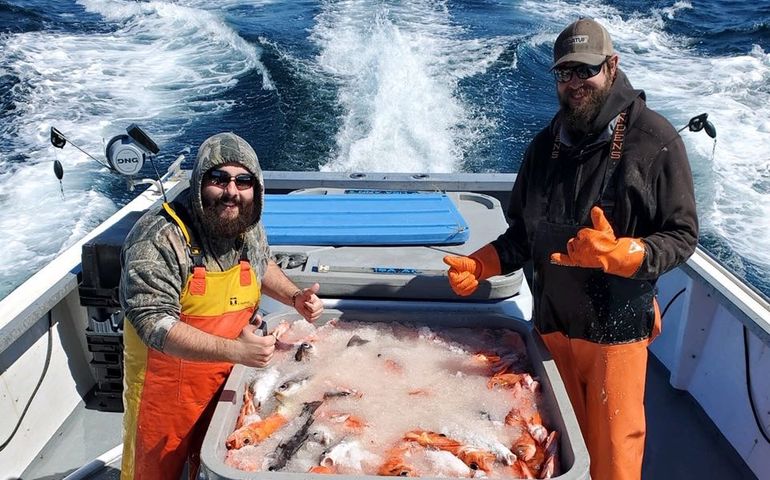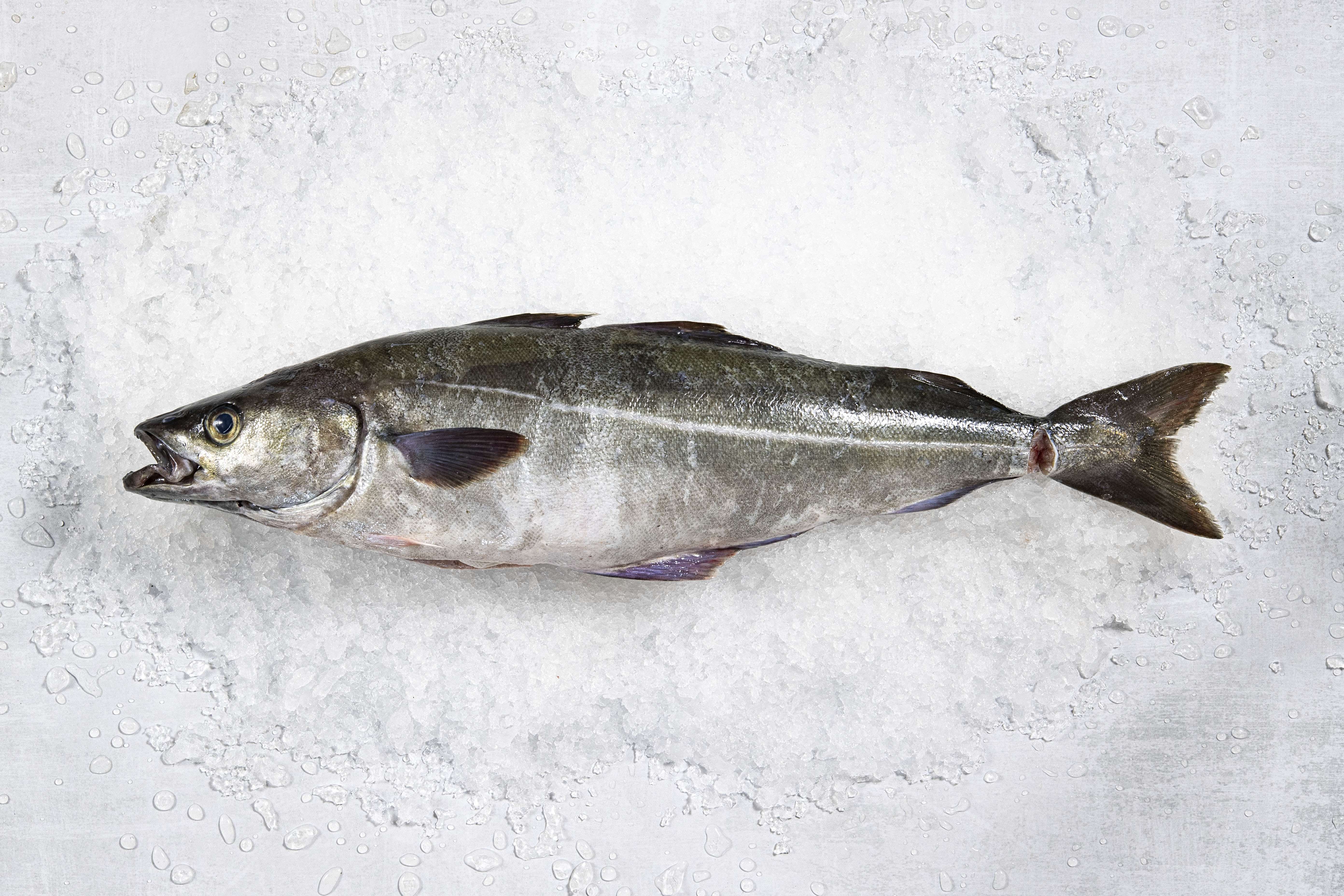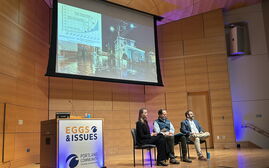
Portland seafood processor is rebuilding wholesale market under new brand name
 Courtesy / True Fin
Crew of the fishing vessel Lady Rebecca, captained by Joe Letourneau (not seen), brings a haul of fish to port for True Fin to process.
Courtesy / True Fin
Crew of the fishing vessel Lady Rebecca, captained by Joe Letourneau (not seen), brings a haul of fish to port for True Fin to process.
Like many seafood processors last year, a business then called Gulf of Maine Sashimi pivoted to serve a direct-to-consumer retail market as the wholesale food service industry shut down.
Now the Portland company, renamed as True Fin, has expanded the number of harvesters it works with, is actively hiring employees, and is rebuilding its wholesale distribution network.
“We’re seeing restaurants opening and we’re back to direct-to-chef, fish market and distributor sales across the country,” Jen Levin, the company’s president and CEO, told Mainebiz. “We’ve got a network across the country and we’re seeing these things come back to life.”
Special handling
True Fin is a seafood startup that’s the first “mission-driven” company launched by the Gulf of Maine Research Institute’s business development group, Gulf of Maine Ventures.
The business began in 2019 with the goal of creating a market solution to the persistent problem of low prices and landings for locally harvested Gulf of Maine fish. By training harvesters in specialized handling practices, the company has created a market for the high-quality, sashimi-grade, sustainable fish.
The company has since grown to market a range of wild and farmed species.

The name change reflects the company’s commitment to transparency, traceability and authenticity, according to a news release. True Fin’s newly launched website includes information about sustainability, Gulf of Maine harvesters, cooking tips and an online sale portal.
True Fin buys seafood directly from boats in Maine, New Hampshire and Massachusetts. In exchange for specialized quality handling, the company pays fishermen a premium over traditional markets.
The catch includes finfish species such as cod, pollock, hake and monkfish, as well as seasonally available items like tuna, halibut, squid and scallops. The company cuts the fish at its Portland facility and ships to chefs and home cooks across the country.
True Fin is located in a 6,000-square-foot facility on Deake’s Wharf on the Portland waterfront. The site includes offices, dry storage and clean rooms for cutting, packaging and storage. Fish are hand cut.
More harvesters
In 2020, True Fin was working with about two dozen harvesters, most from Maine.
“We’re well over 30 boats now,” although the number varies with the season and includes a core of 10 year-round boats, said Levin.
Most are now based in New Hampshire and Massachusetts. Even some Maine-based boats are landing product in those two states in order to be closer to markets during the pandemic, she added.

Fishermen receive at least a 20% premium over standard auction prices. Depending on species and time of year, the premium could be as high as 400%. The company also establishes price floors for different species.
In turn, True Fin requires harvesters to use best-handling practices in order to optimize product quality.
Conventional handling often involves stowing fish in the hold, where they slowly suffocate. Stress during that time produces natural chemicals that get into the meat and break it down more quickly.
Best-handling practices are modeled after the Japanese practice ikejime, which means "to kill with purpose." The fish are killed with a brain spike, which renders it brain-dead and eliminates stress. But the heart is still pumping. The fishermen then cut the fish at the gill and tail so they bleed out. After it’s bled, it goes into a salt-water ice slurry, where it cools quickly. Between the reduction of the stress-inducing chemicals and bleeding it out, the fish has a better texture and better taste, and lasts a lot longer because it doesn’t break down as quickly.
The direct-to-consumer model worked well for moving product last year, Levin said.
“We lost all our customers in mid-March 2020, so we transitioned to the direct-to-consumers sales model,” she said. “People showed up at designated parking lots for pick-up. We heard from a lot of these folks that they started eating seafood more, that they were becoming more familiar with more Gulf of Maine species.”
Over the past 15 months, True Fin had a couple of thousand local consumers who picked up fish from the parking lots.
Earlier this month, True Fin ended parking lot pickups as wholesale distribution ramped up.
“It was hard to say goodbye to folks we’d been seeing face-to-face for over a year,” she said. “Although it had dwindled quite a bit as people were getting back to work and people are going out more now. The timing was right.”
With restaurants opening up, the company is back to working with the restaurant and distributor portfolio it had built before 2020, with more coming online.
“We’ve got a nice, diverse portfolio we’re working with, including Michelin-starred restaurants as far as California, ordering from us week over week,” she said.
In April 2020, sales were all direct-to-consumer.
This past June, direct-to-consumer was down considerably while wholesale shot back up.
Keeping in touch
It wasn’t difficult to reestablish wholesale relationships.
“Throughout COVID, even when restaurants were closed and when distributors didn’t have business for us, I kept in touch with them,” Levin said. “I called and checked in to see what plans they were making. It was just reaching out and keeping in touch throughout the pandemic, even knowing that no one was in a position to purchase anything.”
One of the most successful means of getting on the radar of chefs is social media, she added.
“When our chef-partners tag us and post and say they’ve got this glorious fish from us, other chefs notice that,” she said. “Sometimes it’s geographic. A chef in Nashville posts something; next thing we know, we’ve got this neat little cohort of Nashville chefs.”
Last year, True Fin issued a $1 million convertible note to support its growth. The financing allowed the company to invest in marketing and the new brand, with necessities such as new packaging. It provided cash flow that allows the company to purchase product from fishermen right away while freezing inventory for year-round sales; invest in equipment designed to increase production efficiency, including a large-capacity vacuum seal machine that packages one-pound portions for online sales; and hire an operations manager.
A new piece of equipment is a Japanese “super freezer” that preserves seafood at minus-76 degrees Fahrenheit.
Employee numbers have grown from three before the pandemic to seven today. During the pandemic, Levin hired many out-of-work chefs part-time.
She’s now looking to hire.
“We have one new part-time person who will be full-time in the fall,” she said. “We’re looking to hire two more — at least one fish cutter and one for operations.”
Levin said pay is competitive and full-time staffers receive a competitive benefit package that includes health, paid time off and the opportunity to invest in a retirement plan with an employer match.
The company is also seeking to recruit new fishermen.
“My head of sourcing, Brendan Landry, is on the phone nonstop reaching out to fishermen,” Levin said. “He goes down to the docks. If he knows about a boat he’s interested in working with, he’ll leave his card on the boat with a note if he can’t track down the fisherman. He’ll also go out on the boat with them. He’s critical to what we do.”
Mainebiz web partners
As a local consumer in Portland that supported Gulf of Maine Sashimi through the pandemic, I feel abandoned. It's great to support the many fine businesses and restaurants that are coming back to full swing, and I'm glad they are growing their business, but to abandon those of us that supported them in a time of need direct to consumer was not a good move.













1 Comments